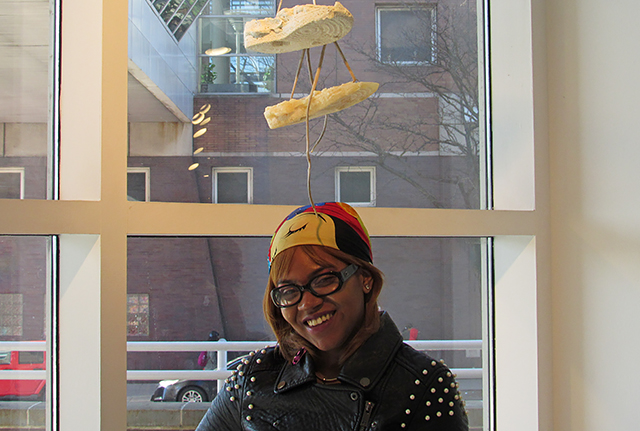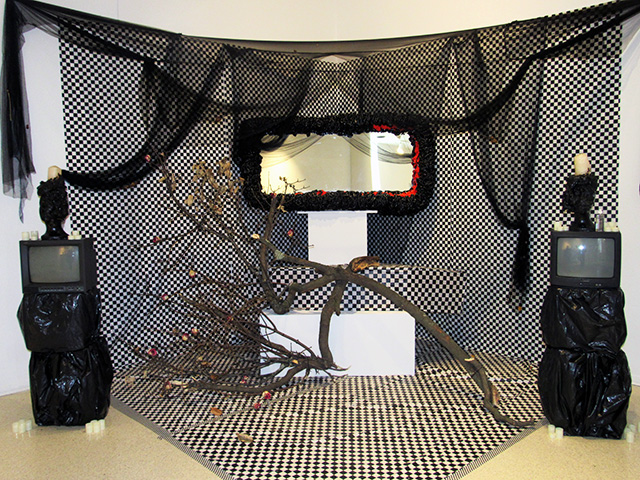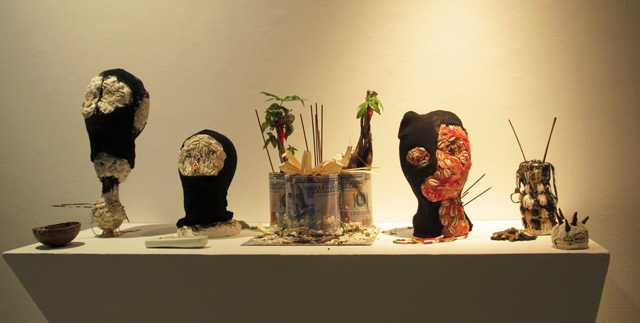Art Reveals Displacement, Poverty and Exploitation

Audreamia Wardlow
By Jessica Postell
On February 14 Audreamia Wardlow sat staring out the gallery window, daydreaming about the times she would later spend with her love. She made a quick mental note of the things she would have to pick up: chocolate, gummy bears, rose petals, and maybe a bottle of wine if the evening called for it. Tonight would be a night of uninterrupted passion, where she would get dirty making what she loved most in the world, art. Suddenly, she looked up at her artwork already on display and smiled, deciding that tonight would have to wait, she would instead spend today reveling in the excitement of having her work tell a story to the masses.

Wardlow, 25, is one of the 10 artists whose work is on display at the Longwood Art Gallery @ Hostos in an exhibition called The Update, which is on display until February 26. The collective includes works done by nine other artists, who are also under the age of 30. Their pieces tell stories of displacement, poverty, and exploitation happening right now in the Bronx. The use of mixed media is an ode to the borough’s diversity, connecting nationalities, and races. The exhibit updates the narrative of the Bronx of the past and shape a new one for the Bronx to come.
Growing up around Fordham Road and Sedgwick Avenue in the Bronx, Wardlow is no stranger to the adversities Bronxites of color face. The internalization of black exploitation is a social issue she seeks to both expose and address in her latest piece named Sugar Soles. “We have traded our souls for these soles,” she said, pointing to her chandelier sculpture which depicts the soles of Nike Uptowns, Air Jordan 1s, and Air Force ones, some of the most iconic sneakers worn by minorities in poor neighborhoods. “We are more interested in wearing the sneakers for the name as opposed to appreciating them for their function.”

Wardlow says that she used sugar to make the soles as a reminder of the extensive history of the black experience in America. Citing how the commodity which once made America wealthy off the labor of black slaves was now making America wealthy off the addiction of black people. “People of color are dying left and right because of these sugar addictions,” she said. “Diabetes and the likes have gotten out of control. We must be more vigilant of what is being done to us that we may stand up and fight back.”
Wardlow also believes that there is a spiritual connection between our soles and our souls. “Sneakers have always been a symbolization of self-identity,” she says. Insert dialogue?? Defending what we wear on our feet eventually becomes a part of who we are. “Our sneakers create a narrative between our spiritual selves and our material selves,” she said, emphasizing that she sees no disconnect between the secular and the spiritual. “Our sneakers are the vehicles that allow us to navigate the world and protect us from obstacles while in the streets,” she said. “They provide us with access to spaces and places.”
Wardlow is not the only person that believes in the connection between material and spiritual. Up-and-coming artist Precious Shante believes in this connection as well. “We are indeed what we wear,” she said. “When I wear a pair of stilettos, I become an entirely different person than if I am just lounging in my jays, the spirit knows how to act per whatever it is we put on.”
Kim Davis, who attended the opening reception of the exhibition on January 8, said she was moved by the artwork. “I could see the Bronx in each piece, some excited and some threatened to make me cry,” she said. “But I am glad to have been there to see it unfold. I have lived in the Bronx for over 30 years, and this was my first time seeing something like this.”
Another attendee, Malik Freeman, who visited the exhibition two weeks after it opened, expressed the anguish stirred in him by the works. “When I see the red, it reminds me of all the blood we shed too often and just how lost the youth of the Bronx are these days,” he said. “There must be a change in what we teach and show our children, but I am glad at the steps these young people are taking representing the borough.”
Samir Dillard, a long-time resident of the Bronx, was not impressed with the work he saw on display. “You call this art?” he said. “Voodoo dolls and throwing paint on canvas does not constitute as art. This is what’s wrong with the Bronx now. People throw a smile and a few slices of cheese on the paper and want us to believe that it is a masterpiece.”
Our souls are light, says Wardlow. “I am determined to let my light shine through my work,” she said.
Saved under Culture, Featured Slide
